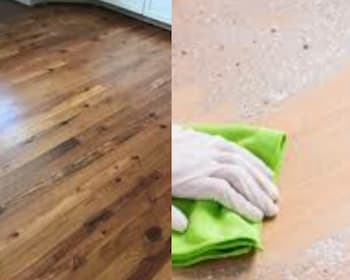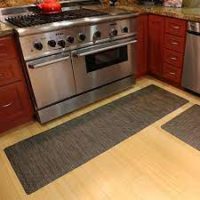How To Remove Tar From Vinyl Floors?
Vinyl flooring is a popular type of hardwood floor for homes. They add style and beauty to any place for a luxurious look.
It is the most common question of homeowners who are in contact with newly formed road and tar. The tar comes in the home with shoes and vehicles and will stain the floor. If you do not clean the floor immediately, it creates permanent stains that are hard to remove.
The second most important reason is seeping in tar-based linoleum. The tar-based linoleum sometimes seeps and leaves black sticky marks on the floor.
How To Remove Tar From Vinyl Floors?
Different methods are applied to remove tar from the linoleum. When tar on the linoleum flooring dries, it may cause a problem. The scratching method is best. However, it may damage the vinyl floor with scratch marks.
You can utilize the putty knife to scrape the tar from the linoleum and luxury vinyl flooring.
Remove stains from tile or vinyl carefully using the appropriate technique.
Is Wax Remover Safe To Remove Tar From The Vinyl Or Linoleum?
Yes, many removers can remove it from wood, tiles, linoleum, and vinyl hardwood floors. Remember that not all products are protective for floor cleaning. Some leave adhesive residues and also create a mess instead of removing the stain.
I use and recommend WD-40 Multi-Use Spray Remover.
Some months ago, the melted tar paper stained my vinyl flooring. The floor was newly installed and I was worried about it. I see the spray reviews and take chance or risk.
Can you imagine that it removes all the marks at once without spending energy? I spray and allow time for it to work.
Why do I Love WD-40 Multi Spray?
- It effectively works on all glue, tar, and grease.
- Help to get smooth and shiny sheet vinyl flooring
- Cleans all the old and new marks
- Does not leaves residue on the flooring
- Best to clean and remove bitumen tar from floors
- Removes tar from walls, clothes, and car tires without staining
- It loosens and stubborn the spills
- It scrapes off as much excess tar as you can using it onto the tar.
- It does not bleach the carpet
- Directly pour on floor, vehicle, and furniture
- It does not wear the floor polish
- It is one of the best ways for candle wax removal
- It is original and relatively not the dull floor.
- It is easy to spread
- It enhances the life of the floor
How To Apply WD-40 Cleaner?
It uses oil to penetrate the tar, lubricate it and lift from the affected area.
Follow these steps for great results.
- Take a damp cloth and spray the WD-40 on it. You can also use it without a towel.
- Rub the towel gently on the spot to penetrate it
- After applying, soak it and wait for a maximum of 30 minutes
- After half an hour, take another microfiber towel for rubbing until the spot removed
- Repeat the process if you are not satisfied.
What I Don’t Like About WD-40?
I use it on vinyl floors smoothly and got great results. It makes me happy and relaxing by solving all the issues and preventing my vinyl plank.
One of My friends uses it on a vinyl window, and he observes some sticky leftovers. So, try to avoid it.
Is WD-40 Cost-Friendly?
Well, it depends on your budget and pocket. The 12 fluid ounces item is available for $4.65. You can see further deal packages and discounts on it.
The product rating is 4.8 out of 5
Can You Use Peanut Butter For Removing Tar?
Peanut butter is oily and penetrates in adhesive tar to separate the molecules.
It is a simple removing method for any hardwood flooring.
What You Will Need?
- Scrapping tools
- Non-serrated butter knives
- Peanut butter
- Paint stirring stick
- Towel
How To Utilize These Ingredients?
- Scrape off the extra tar with a scrapping tool and knife
- Make a thick layer of mineral oil and peanut butter on the affected flooring
- Again start the scrapping. Don’t wipe off or clean the oily material
- Again pour some peanut butter. It will clean wood and tiles
- Let it sit for a few minutes for perfect cleaning.
- Select degreasing cleaners to remove the oily material
- It also used for glue and paint
- Take a clean rag and apply on the area
- Rinse the towel paper carefully with clean water for the removal of residue.
- If any oily material remains on the flooring, it may start slipping and you can get an injury.
- So, take precautions and save yourself
Which Is A Recommended Degreaser?
I prefer a simple green degreaser against grease and mineral spots.
It does not contain any hazardous and toxic chemicals.
The biodegradable flameless deodorizer works on all linoleum, sheet vinyl, and hardwood floors.
I used it on my kitchen’s upholstery. It does not make the floor surface dull and black.
The thing that enforced to me to like it is its cleaning mechanism. You can observe adhesive-free carpet, wood, sink, and tiles by using a green degreaser. It also produced a pleasant scent due to its deodorizing nature.
I use it in my house without having any issues.
How To Remove Tar From Vinyl Floors-Final Thoughts
The bitumen is a common type that comes in the house with vehicles. The paper-based is also observed in the newly constructed building due to any exposure to heat. Select top-rated items whether the stain is old or wet.
This problem needs oil-based and water-based easy-to-use solutions for properly removing. The same method will be applied to remove paint and glue. In the summer season, ice is frozen and hardens the tar.
Instead of knives, the clean plastic scraper is also helpful on the tile flooring.
The tarred paper is used during roof construction for waterproof and weather-resistant purposes. It avoids all seeping problems.
A scraper removes much of the stains. It also creates scratches on the vinyl flooring.
So, you should be very careful while applying any method on your costly vinyl flooring.
Contents






